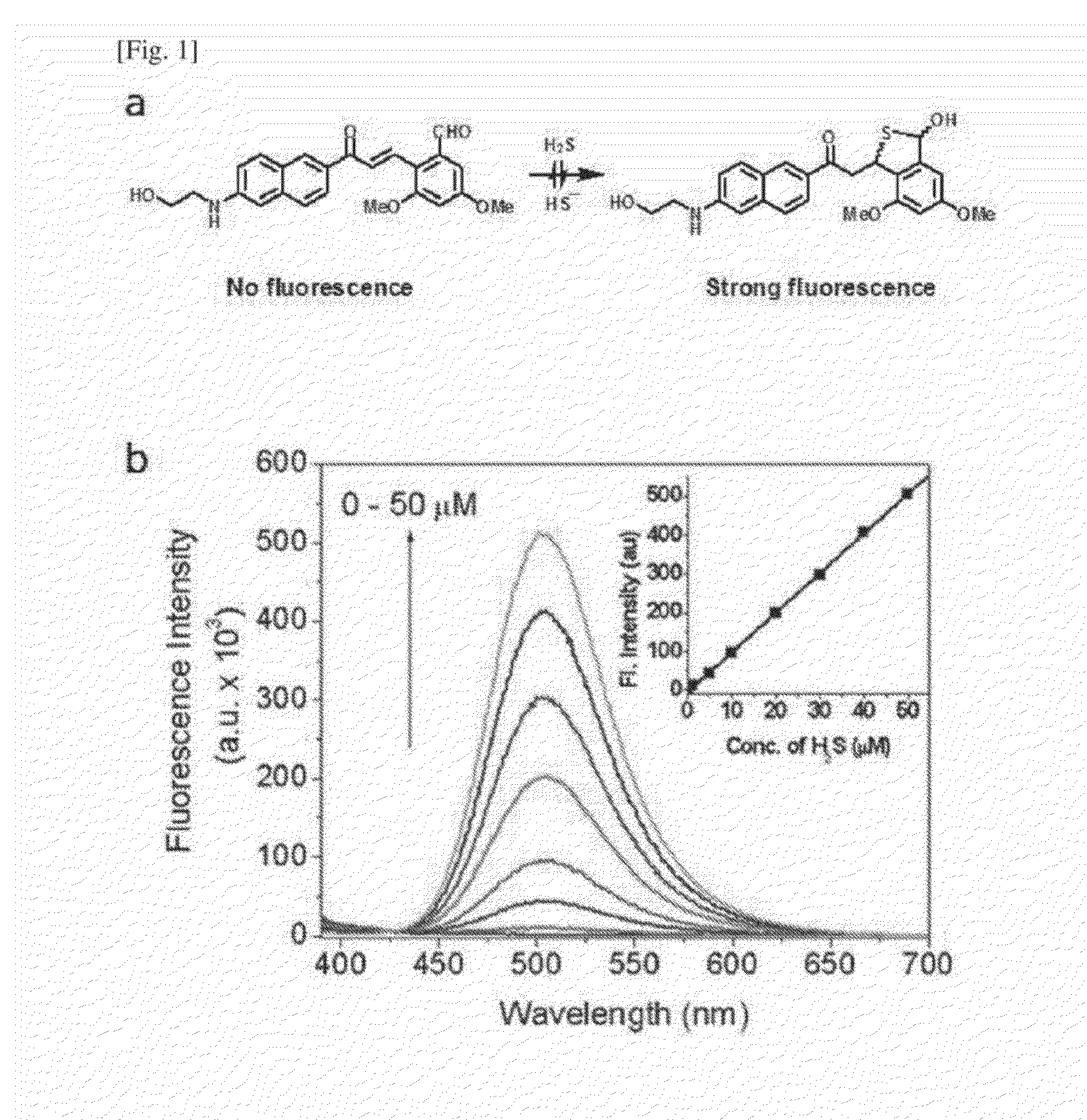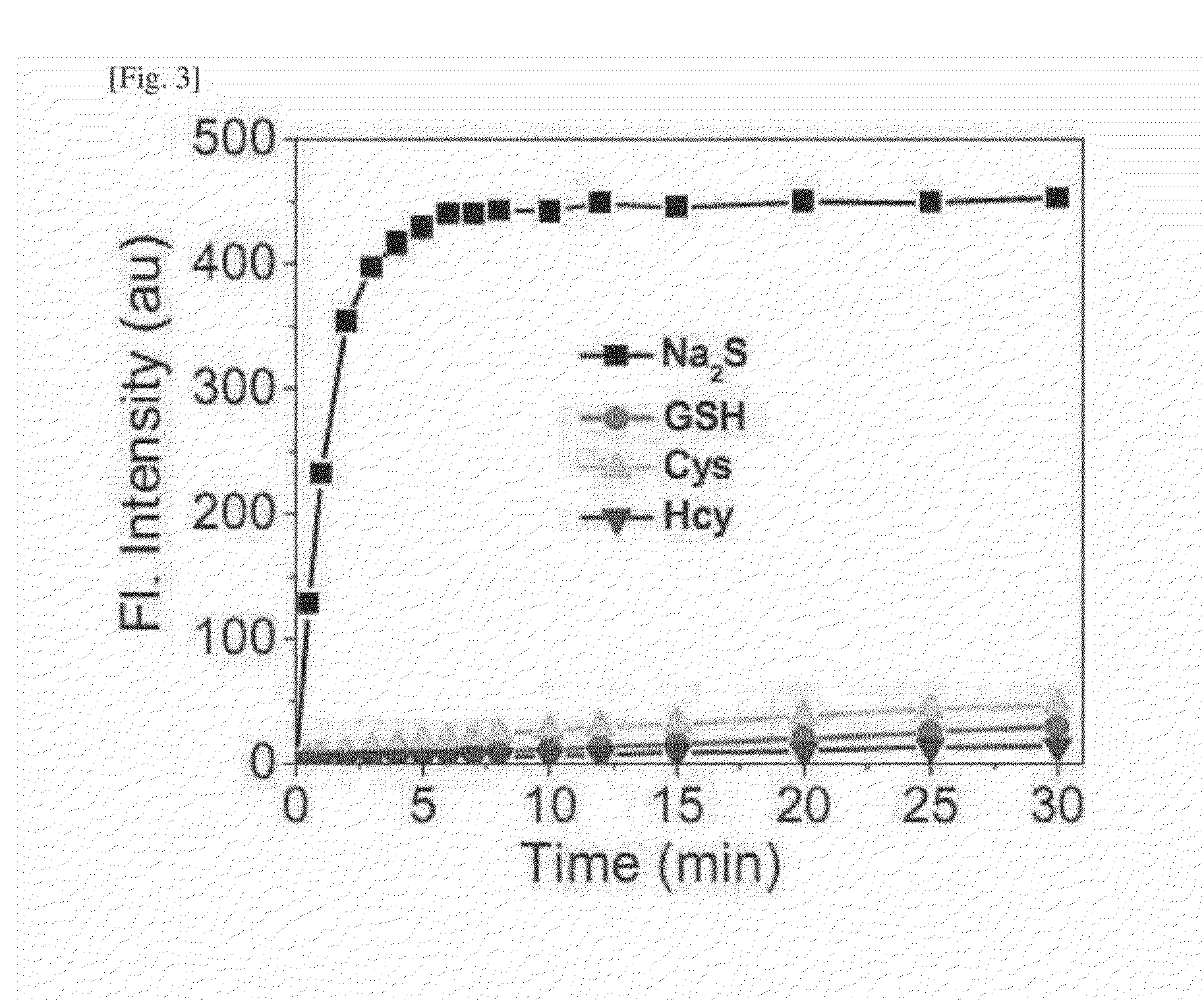One-Photon and/or Two-Photon Fluorescent Probe for Sensing Hydrogen Sulfide, Imaging Method of Hydrogen Sulfide Using Same, and Manufacturing Method Thereof
a fluorescent probe and hydrogen sulfide technology, applied in the field of onephoton and/or twophoton fluorescent probes for sensing hydrogen sulfide, imaging methods of hydrogen sulfide using same, and manufacturing methods thereof, can solve the problems of low selectivity of fluorescence sensing methods for hydrogen sulfide using arylazide, inability to perform in vivo analysis, and low response rate, so as to achieve high-resolution images, low cell destruction
- Summary
- Abstract
- Description
- Claims
- Application Information
AI Technical Summary
Benefits of technology
Problems solved by technology
Method used
Image
Examples
synthesis example 1
Synthesis and Structural Analysis of Compound 2
[0057]Compound 2 of Formula 2 was synthesized according to the pathway represented by Reaction Formula 1 by the inventors.
[0058]Step 1-1: Synthesis of 1-(6-(2-hydroxyethylamino)naphthalene-2-yl)ethanone
[0059]To synthesize Compound 6 of Reaction Formula 1, which is 1-(6-(2-hydroxyethylamino)naphthalene-2-yl)ethanone, first, Compound 5 (6-bromo-2-naphthol, 2 g, 8.97 mmol, Sigma-Aldrich, B73406) as a starting material for synthesis, Pd(OAc)2 (100 mg, 0.45 mmol) and diphenyl-1-pyrenylphosphine (DPPP, 370 mg, 0.9 mmol) were put into a reaction vessel containing ethylene glycol (15 mL). Subsequently, 2-hydroxylethyl vinyl ether (2.37 g, 27 mmol) and triethylamine (3.12 mL, 22.4 mmol) were put into the reaction vessel, and stirred at 145° C. for 4 hours. After 4 hours, the temperature of a reactant was reduced to room temperature (25° C.), the vessel was open to put dichloromethane (15 mL) and 5% HCl (30 mL) thereinto, and then the resultant m...
synthesis example 2
Synthesis and Structural Analysis of Compound 3
[0075]The inventors synthesized Compound 3 of Formula 3 according to the pathway represented by Reaction Formula 2.
[0076]Step 2-1: Synthesis of 2-(3-methoxyphenyl)-1,3-dioxolane
[0077]To synthesize Compound 12 of Reaction Formula 2, 2-(3-methoxyphenyl)-1, 3-dioxolane, Compound 11 (1.0 g, 7.34 mmol), which was a starting material for synthesis, was dissolved in toluene (20 mL). In addition, ethylene glycol (611 μL, 11.02 mmol) and p-toluenesulfonic acid monohydrate (140 mg, 0.734 mmol) were added, and the resultant mixture was refluxed in the Dean-Stark apparatus for 24 hours. After 24 hours, a reaction vessel was cooled to room temperature, 5 mL of a saturated KOH-EtOH solution was added, and the resultant mixture was stirred at room temperature for 30 minutes. 50 mL of H2O was added, and an organic layer was extracted using EtOAc (50 mL). The organic layer obtained by extraction was dehydrated with Na2SO4 (5 g) to remove residual water ...
synthesis example 3
Synthesis and Structural Analysis of Compound 4
[0085]The inventors synthesized Compound 4 of Formula 4 according to the pathway represented of Reaction Formula 3.
[0086]Step 3-1: Synthesis of 2-(1,3-dioxolan-2-yl)benzaldehyde
[0087]To synthesize Compound 16 of Reaction Formula 3, 2-(1,3-dioxolan-2-yl)benzaldehyde, Compound 15 (1.0 g, 5.4 mmol) as a starting material for synthesis was dissolved in toluene (20 mL). In addition, ethylene glycol (0.5 mL, 8.1 mmol) and p-toluenesulfonic acid monohydrate (102 mg, 0.54 mmol) were added, and refluxing was performed in the Dean-Stark apparatus for 24 hours. After 24 hours, a reaction vessel was cooled to room temperature, 5 mL of a saturated KOH-EtOH solution was added, and then the resultant mixture was stirred at room temperature for 30 minutes and mixed with 50 mL of water. From the above mixture, an organic layer was extracted with EtOAc (50 mL). The obtained organic layer was dehydrated with Na2SO4 (5 g) to remove residual water therein, ...
PUM
| Property | Measurement | Unit |
|---|---|---|
| temperature | aaaaa | aaaaa |
| height | aaaaa | aaaaa |
| diameter | aaaaa | aaaaa |
Abstract
Description
Claims
Application Information
 Login to View More
Login to View More - R&D
- Intellectual Property
- Life Sciences
- Materials
- Tech Scout
- Unparalleled Data Quality
- Higher Quality Content
- 60% Fewer Hallucinations
Browse by: Latest US Patents, China's latest patents, Technical Efficacy Thesaurus, Application Domain, Technology Topic, Popular Technical Reports.
© 2025 PatSnap. All rights reserved.Legal|Privacy policy|Modern Slavery Act Transparency Statement|Sitemap|About US| Contact US: help@patsnap.com



